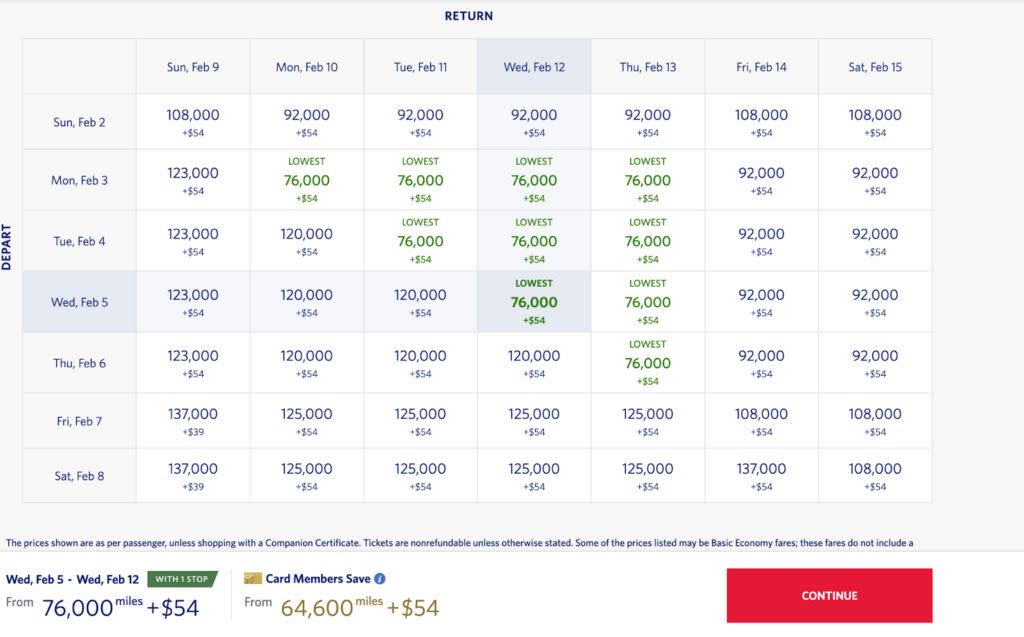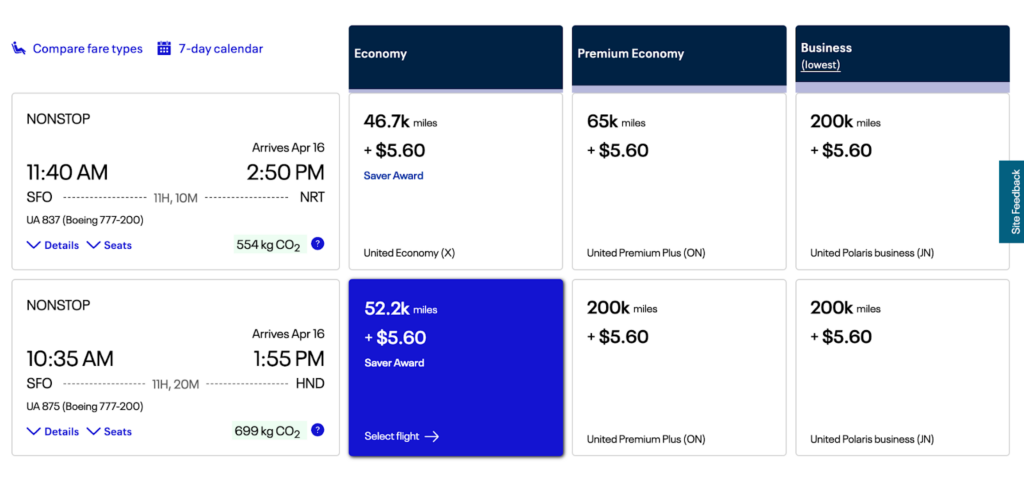Contents
- 1.
- 2.
- 3.
One of the best ways to spend your credit card rewards is on a free flight to Japan, a bucket-list destination for plenty of U.S. travelers. But those long-haul tickets don't necessarily come cheap, and award space can be difficult to find, whether you fly economy or splurge on business-class redemptions.
Here's what you need to know about getting to Japan using points and miles.
How many miles or points do I need to fly to Japan?
The number of airline miles or points you need to fly to Japan depends on the carrier you book with, the loyalty program you choose, and factors like your preferred cabin class and travel dates. As a general guide, you can expect to spend at least 35,000 points one way in economy and 80,000 to 200,000 points in business class.
When should I book flights to Japan with points?
We recommend booking flights to Japan either very early (when award seats are first released, typically 11-12 months in advance) or relatively last minute (about two weeks out). That’s because award availability is at its highest when seats are first released and can decrease the closer you are to departure, particularly during busy travel months, like November through January or during cherry blossom season (late March to early May). However, some airlines also release unsold seats for award bookings as departure approaches, so you could get lucky at the last minute.
Which airlines and alliances travel to Japan?
A handful of airlines and alliances travel nonstop from the US to Japan. These include:
Oneworld: Japan Airlines, American Airlines
Star Alliance: All Nippon Airways (ANA), United Airlines, Singapore Airlines
SkyTeam: Delta Air Lines
Hawaiian Airlines: nonstop service from Honolulu

What are the best frequent flyer programs for travel to Japan with points and miles?
Different airline partners allow you to redeem miles at different rates. These are our top picks for travel to Japan.
Delta SkyMiles
Delta may not use an award chart, but searching for award availability with SkyMiles is pretty simple — although it's rarely cheap, especially in premium cabins like Delta One business class. You’ll generally spend fewer miles when you book your ticket months in advance, especially in economy.
For instance, a round-trip, one-stop flight from New York to Tokyo starts at just 76,000 SkyMiles — and even less if you have a Delta SkyMiles credit card.

You’ll find the cheapest award flights in basic economy (which is extremely limited in terms of checked baggage, seat selection, etc.), so if you want more flexibility, we recommend booking Main Cabin at least, particularly on long-haul flights.
While Delta SkyMiles are an excellent option for economy tickets, we don’t recommend using them for business-class tickets, especially to Asia. As you'll see below, round-trip tickets in Delta One can cost as much as 600,000 SkyMiles. There are much better ways to book business-class tickets — even in Delta One, which we’ll cover a little later.

United Airlines MileagePlan
Similar to Delta, United MileagePlan doesn't have an award chart, using dynamic pricing instead. That means award tickets can be cheaper or more expensive depending on several factors, like demand.

Like Delta, United offers affordable economy options — for example, a round-trip economy ticket from San Francisco to Tokyo starts around 100,000 miles.

Also as with Delta, you’ll want to avoid booking United Polaris directly with United. As you see, these awards can cost as much as 200,000 miles each way!
Virgin Atlantic Flying Club
Virgin Atlantic Flying Club is perhaps the best way to book SkyTeam awards. For instance, you can find a round-trip ticket in economy from Los Angeles to Tokyo on Korean Air for just 76,000 points.

We like using Virgin points to book flights to Japan due to how simple they are to earn. The Virgin Atlantic Flying Club program is a transfer partner of Chase Ultimate Rewards, Capital One Miles, American Express Membership Rewards, Marriott Bonvoy, Citi ThankYou Rewards, and Bilt Rewards, making it easy to rack 'em up.
ANA Mileage Club
Finally, ANA Mileage Club represents one of the best ways to book flights to Japan with points, thanks to its zone-based award chart.

With zone pricing, you’ll pay a fixed price with miles when traveling between zones. In this case, Japan is in Zone 1-A and North America is in Zone 6, meaning you’ll pay just 50,000 miles for a round-trip economy ticket on a Star Alliance partner.

ANA first-class and business-class flights can also be extremely affordable, relatively speaking. For instance, it'll cost just 107,500 miles to fly ANA business class round-trip from San Francisco to Tokyo —an absolute steal!

ANA Mileage Club has two transfer partners: American Express Membership Rewards and Marriott Bonvoy. Amex points transfer to ANA Mileage Club miles at a 1:1 ratio, while Marriott Bonvoy points transfer at a ratio of 3:1.
Which Japanese destinations are best to fly to with points?
If you're traveling from the U.S. to Japan on points, the easiest and cheapest cities to fly to are:
Tokyo: Haneda (HND) or Narita (NRT) international airports
Osaka: Kansai International Airport (KIX)
What are the best stopover destinations between the US and Japan?
Cities in the Middle East, Asia, and Europe make for some of the best stopover destinations between the U.S. and Japan. Additionally, if you’re looking for a direct flight from the US to Japan, you could look at booking one flight to a gateway like LA, San Francisco, or Honolulu, having a layover there, and then flying directly to Japan.
Middle East: Dubai, Abu Dhabi, and Doha
Asia: Hong Kong, Singapore, and Taipei
Europe: London and Helsinki
Booking an award flight to Japan with point.me
Don’t have the time or inclination to search multiple platforms to find the best deals? Our cutting-edge approach to points curation makes it easy. Here’s how to book an award flight to Japan using point.me.

You’ll see your results on the next page. You can sort by our picks, the quickest flights, or from low point values to high. You can also filter by airlines, times, and programs.

You’ll see how many points are required on the right-hand side of the screen. If there are any transfer bonuses, they'll be noted here as well. Select your outbound and return flight.

On the final page, you'll see options to book your award flight. You can either do it yourself, or we can handle it for you. And that’s it!
Frequently asked questions about flying to Japan on points and miles
Can I use my frequent flyer miles to book flights for someone else?
Yes, you can book flights for someone else by pooling and/or transferring points and miles to their account or by booking it for them directly in their name.
Can I transfer or gift my points or miles to someone else?
Yes, depending on the airline, you can transfer or gift your points or miles to someone else, though there is often a fee for this.
How many points or miles do I need for a free flight to Japan?
You will need at least 30,000 points or miles for a free flight to Japan in economy class.
Which credit cards are best for traveling to Japan with points?
Some of the best credit cards for traveling to Japan with points are the Amex Platinum, Chase Sapphire Reserve, and Capital One Venture X card, due to their many transfer partners. The Delta SkyMiles Reserve American Express Card is also a solid option, particularly for booking SkyTeam award flights.
Unlock the power of your points! Get 6-12x the value when you search with point.me.Join now



